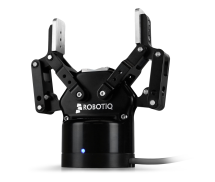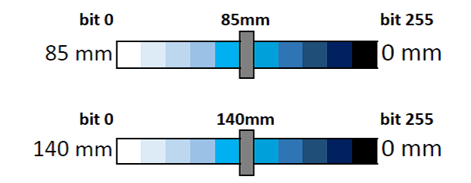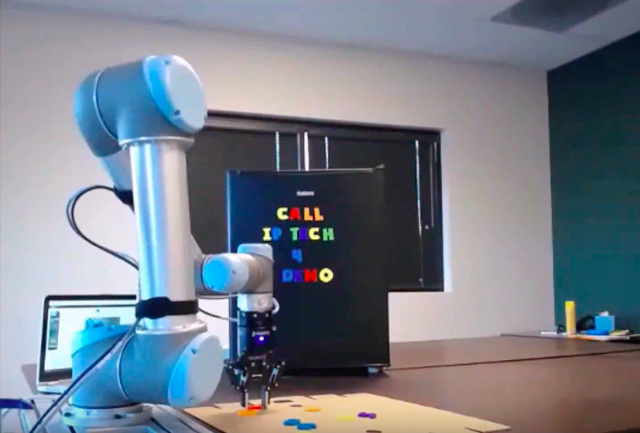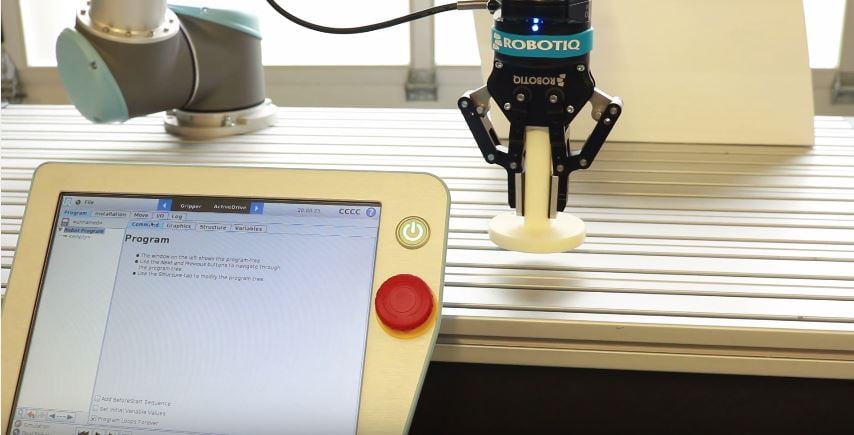Set your Robotiq Gripper by Simply Reading this Blog Post

Posted on May 24, 2016 7:00 AM. 4 min read time
Robotic Grippers are usually used to do very repetitive task for a huge amount of time and a tremendous amount of cycles. Grippers are usually designed to have a given speed and a given stroke, however, what happens if you need two different speed or positions in a single cycle? Well, adaptive Grippers, such as Robotiq 2-Finger 85 Adaptive Gripper can be programmed in terms of position, force and speed to optimize your robotic applications. Here’s how it goes.

All Robotiq Grippers are programmed on a 32 bytes format, which means they have 256 bits. For either of the following settings, the 0 is the minimal value (first bit of the sequence) and 255 is the maximal value.
Notice that if you are using a Universal Robot interface, the Robotiq Gripper wizard can be used. In fact this widget allows you to initialize the Gripper, adjust finger position, speed and force. That being said, it can be uniquely used for setting your Gripper not for programming it.
When programming your robot, you can enter the force, speed and position setting directly into the code line. See Instruction Manual for further information.
Position Settings
Our Gripper is designed to be adaptive, which means that it can be adapted to a lot of different geometries within its gripping stroke. This means that whatever the Gripper encounters, it will be able to adapt to its geometry. What we recommend (unless you handle fragile part) is to completely close the Gripper (bit 255) on the object. Once the set force will be reached (see section below) the Gripper will stop.
You can also preset your Gripper to optimize your cycle time. In fact, if you need to grasp a 25mm wide object, why travel from 85 to 25mm at each stroke, right? We usually recommend to open the Gripper 5mm larger than the object and completely close once at the object's height. So with this approach you can set the Gripper to X + 15 bits (+/- 5 mm) and close to bit 255 to grasp the object.
When the Gripper is initializing, it opens its finger from its maximal opening (bit 0) to its completely closed position (bit 255). To prevent wear, the actual maximal opening is bit 3 (85 mm). When the Gripper is in operating mode, it reads a bit 232. The remaining bits (from 232 to 255) are the position in the encompassing mode.
IMPORTANT It does not mean that if you program the Gripper to close at 244 that it will fall into encompassing mode. It means that if you encounter an object and the object requires an encompassing grasp, the finger will fold and the rotation of the motor will allow to go up to 255.

Force Settings
The particularity of the Robotiq Gripper is that you can change force settings on the spot. In other words, if you need to secure a grasp for a given part of the program and you need to handle an egg afterwards, you can do it. The same principle applies, you have 256 different force settings that can be set depending on your part or your application. However, the ‘0’ setting is designed for fragile object and will not have the re-grasp function. This function will be available in all other 255 force settings. Perhaps you don’t want the Gripper to regrasp on a super fragile object when you try to take it right?
The force settings are 5 to 220N for the 85mm Gripper and 10 to 110 N for the 140mm stroke Gripper. Notice that these values have a +/- 10% uncertainty. Since the force is calculated with a mathematical model and the motor current, there is still a bit of variability in the Gripper's gripping force. This means at a very low force you may want to test the particular Gripper for the specific application.


Speed Settings
There aren't much users that will want to use a low speed over a max speed. As we say: ‘Pin it to win it’. You have 256 different speed settings but most of our end users crank the speed up to have a smaller cycle time. But just so you know the Gripper speed can vary from 20 to 150mm/s on a 85mm stroke Gripper and from 30 to 250mm/s for the 140mm stroke Gripper.


With all of this information, you should be good to set your 2-Finger Gripper. Enjoy!








Leave a comment